I figured out another solution just recently which does not need polylines but rather uses the path value for marker icons which can be calculated on the fly.
In a nutshell: you simply create an SVG path string for a quadratic bezier curve from 0 to p2 - p1 and attach it as a marker icon to p1.
Long version:
The pixel coordinates within the container can be obtained invoking google.maps.Projection.fromLatLngToContainerPixel().
The string for a quadratic bezier curve looks like this:
M [startX] [startY] q [controlX] [controlY] [endX] [endY]
We’ll choose (0,0) for the start point, since the marker will by later placed at that point. The relative position of p2 is now e = (p2.x - p1.x, p2.y - p1.y), and the relative position
of the point half way between them is m = (e.x/2, e.y/2). An orthogonal vector to e is o = s * norm(-e.x / e.y, 1), where s is some scaling factor with s = |e|/4 beeing a good starting point. We now have
the control point with c = (m.x + o.x, m.y + o.y) and the path is:
path = „M 0 0 q c.x c.y e.x e.y“
Now that we have that path, we can simply declare an icon:
var icon = {
path : path,
fillOpacity : 0,//important
scale : 1,
strokeOpacity: //yours,
strokeColor : //yours,
strokeWeight : //yours,
clickable : false //important
};
Setting clickable to false is essential, because otherwise the area enclosed by the curve becomes clickable and the underlying map won’t recieve the mouse events. Now we can add a marker to the map with
the path icon as a parameter and the position of p1:
var marker = new google.maps.Marker({
position : p1,
icon : icon,
map : map,
clickable : false,
zIndex : -100 //make the line appear behind ‚real’ markers
});
A few things to note:
- the sign of scaling factor of the orthogonal o determines the „direction“ of the arc („above“ or „below“ e)
- If the zoom level changes, you have to adjust the scaling of the
icons like this:
marker.icon.scale = 1 / 2^(initialZoom -
currentZoom) there is no need to recalculate the path.
Sample:

jsfiddle with hardcoded example using original question's points
relevant code:
var p1 = new google.maps.LatLng(23.634501, -102.552783);
var p2 = new google.maps.LatLng(17.987557, -92.929147);
var markerP1 = new google.maps.Marker({
position: p1,
map: map
});
var markerP2 = new google.maps.Marker({
position: p2,
map: map
});
google.maps.event.addListener(map, 'projection_changed', function () {
var p1 = map.getProjection().fromLatLngToPoint(markerP1.getPosition());
var p2 = map.getProjection().fromLatLngToPoint(markerP2.getPosition());
var e = new google.maps.Point(p1.x - p2.x, p1.y - p2.y);
var m = new google.maps.Point(e.x / 2, e.y / 2);
var o = new google.maps.Point(0, 7);
var c = new google.maps.Point(m.x + o.x, m.y + o.y);
var curveMarker2 = new google.maps.Marker({
position: markerP1.getPosition(),
icon: {
path: "M 0 0 q " + c.x + " " + c.y + " " + e.x + " " + e.y,
scale: 24,
strokeWeight: 2,
fillColor: '#009933',
fillOpacity: 0,
rotation: 180,
anchor: new google.maps.Point(0, 0)
}
});
curveMarker2.setMap(map);
google.maps.event.addListener(map, 'zoom_changed', function () {
var zoom = map.getZoom();
var scale = 1 / (Math.pow(2, -zoom));
var icon = {
path: "M 0 0 q " + c.x + " " + c.y + " " + e.x + " " + e.y,
scale: scale,
strokeWeight: 2,
fillColor: '#009933',
fillOpacity: 0,
rotation: 180,
anchor: new google.maps.Point(0, 0)
};
curveMarker2.setIcon(icon);
});
});
